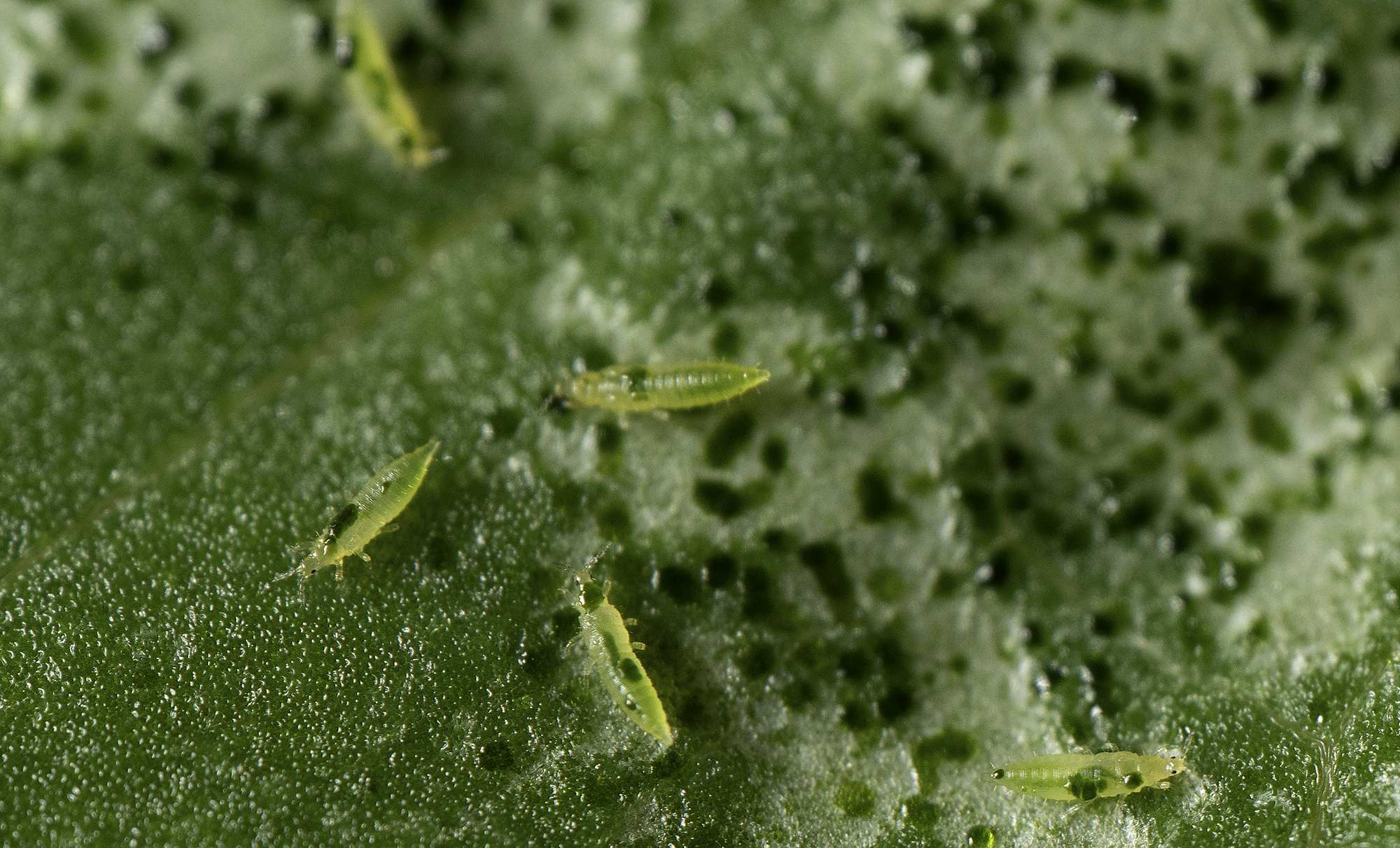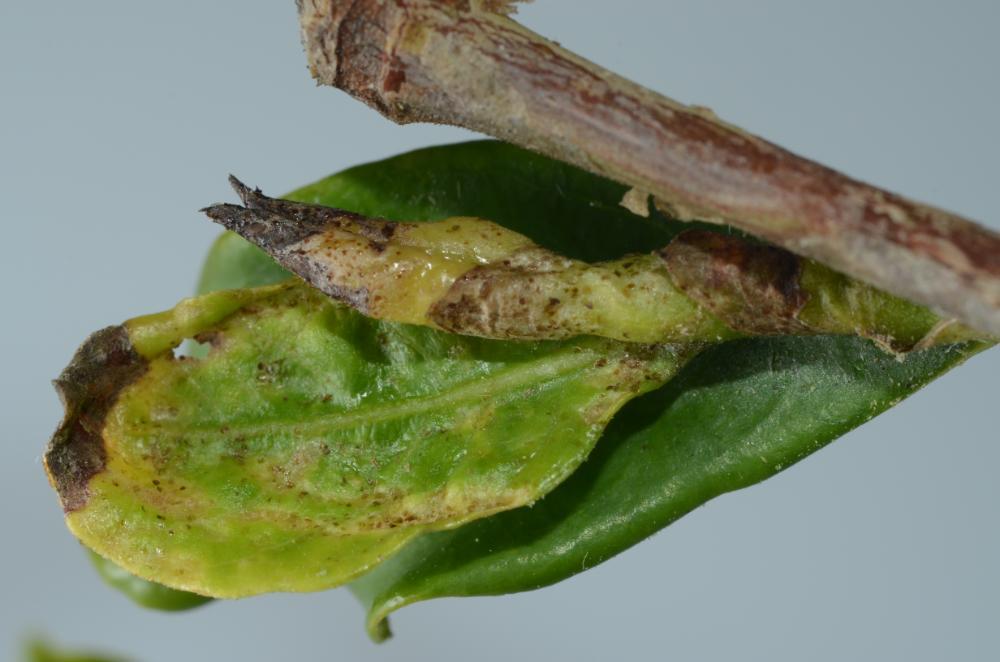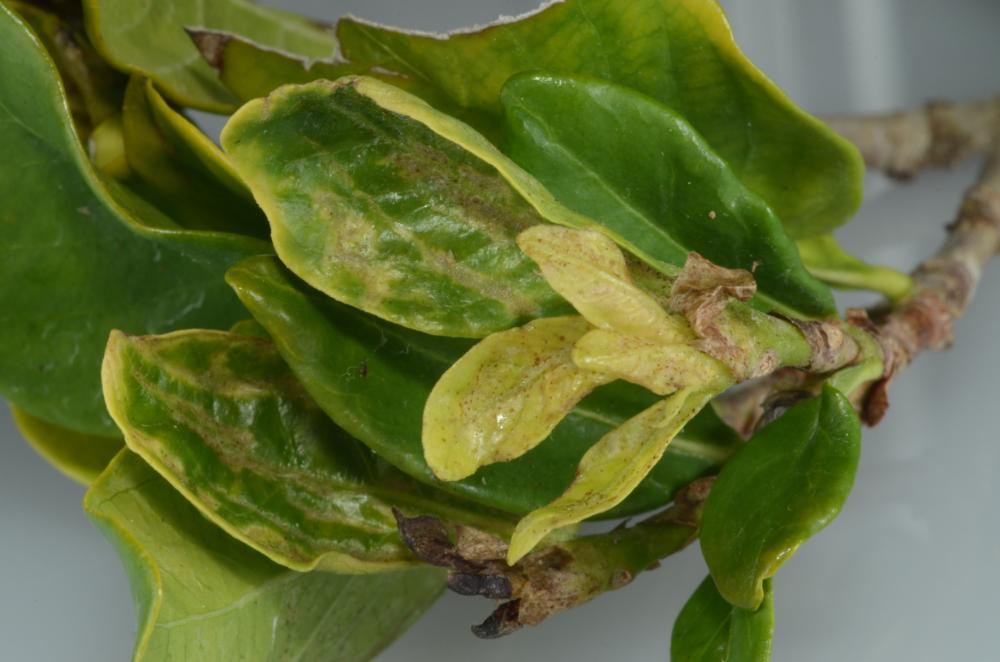Thrips parvispinus (Karny), an emerging invasive and regulated pest in the United States
Authors: Dr. Muhammad Z. Ahmed, Subtropical Insects and Horticulture Research, Agricultural Research Service, U.S. Department of Agriculture, Ft. Pierce, Florida; Dr. Alexandra Revynthi, Tropical Research and Education Center, UF/IFAS, University of Florida, Homestead, FL; Dr. Cindy L. McKenzie, Subtropical Insects and Horticulture Research, Agricultural Research Service, U.S. Department of Agriculture, Ft. Pierce, Florida; and Dr. Lance S. Osborne, Mid-Florida Research and Education Center, UF/IFAS, University of Florida, Apopka, FL.
UPDATED: March 12, 2024
Thrips parvispinus (Karny) (Thripidae) Distribution Update: 10/27/2023
Thrips parvispinus is categorized as Quarantine significant by APHIS, and new state and territorial records have been positively confirmed by APHIS recently. T. parvispinus (Karny) (Thripidae) adult females were collected on peppers (Capsicum annum) on a farm in Corozal, Puerto Rico, and represented a new territorial record. T. parvispinus adult females were collected on Dipladenia, Mandevilla, and Gardenia jasminoides flowers at a garden center in Arvada (straddling Jefferson and Adams counties), Colorado. The plants originally came from South Florida and represent a new state record for Colorado. Adult females were collected from Gardenia jasminoides foliage and flowers at a Food Lion in Tifton, Georgia, representing a new state record. In North Carolina, adult female thrips were collected from two retail locations in Charlotte (Mecklenburg County), one from Gardenia jasminoides and the other location on both Gardenia jasminoides (flowers and foliage) and Dipladenia (flowers), and these collections represent new state records for North Carolina. In Lancaster, South Carolina, adult female thrips were collected from Gardenia jasminoides at a retail nursery, representing a new state record. Interceptions have been made in Ohio and Pennsylvania.
- New posts in Resources section below including a post regarding a New Mailing List for this pest.
- Some new information on chemical controls in the Control Options section below plus a short summary list.
- University of Florida Extension Thrips parvispinus Webinar May 4, 2023 (link in Resources section).
- tHRIve - WEB SERIES May 10, 2023. Thrips parvispinus: Identification, Scouting, and Potential Controls. https://www.hriresearch.org/thrive-web-series
- Pest Thrips of the United States: Field Identification Guide (link in Resources section).
- Added a photo of T. parvispinus pupating in the soil.
- Links to 2 websites and a new paper on Chemical Control added in the Resources Section at the bottom of this page (1/25/24).
- There is also a link to a PowerPoint presentation (1/25/2024).
- There is excellent content being presented on websites by Dr. Sarah Jandricic and Dr. Alexandra Revynthi (links in the Resources Section)
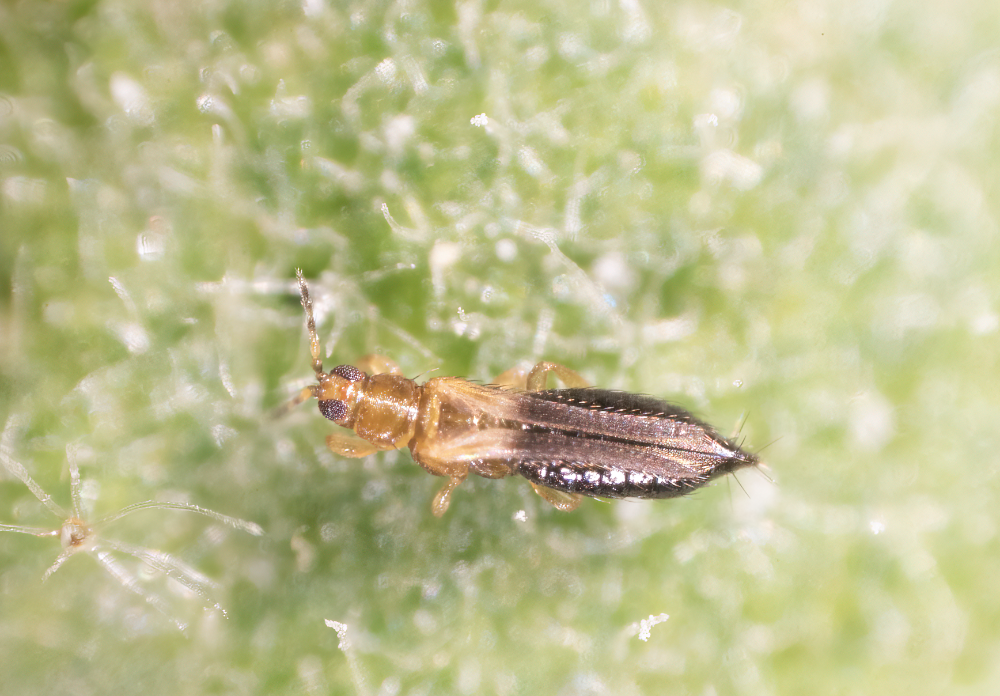
Photo: L.S. Osborne, UF/IFAS-MREC
- Adult female Thrips parvispinus feeding on eggplant. The males are smaller and yellow (see video)
- Please use the following citation for this webpage:
- Ahmed, M.Z., A.M. Revynthi, C.L. McKenzie, and L.S. Osborne. (2023). Thrips parvispinus (Karny), an emerging invasive regulated pest in the United States. [https://mrec.ifas.ufl.edu/lsolab/thrips/thrips-parvispinus/]. [Date Accessed].
- Thrips are small, slender insects belonging to the order Thysanoptera. They are typically about 1–4 mm long and range in color from yellow to brown or black. Thrips have worldwide distribution and are pests in various crops, including fruits, ornamentals, and vegetables.
- They have distinctive wings that are long and narrow, with fringe-like edges. They use their wings to fly short distances and jump. Thrips feed by piercing the plant tissue and sucking the sap, which can cause damage to the plant and reduce its growth and yield.
- Thrips can harm the crops indirectly by transmitting plant viruses. Some species of thrips, however, are predators and are used in biological control programs to manage pests.
- Below there are 23 thrips species reported from ornamental plants in Florida, including 11 with dark bodies, five with light to dark bodies, and seven with light-colored bodies.
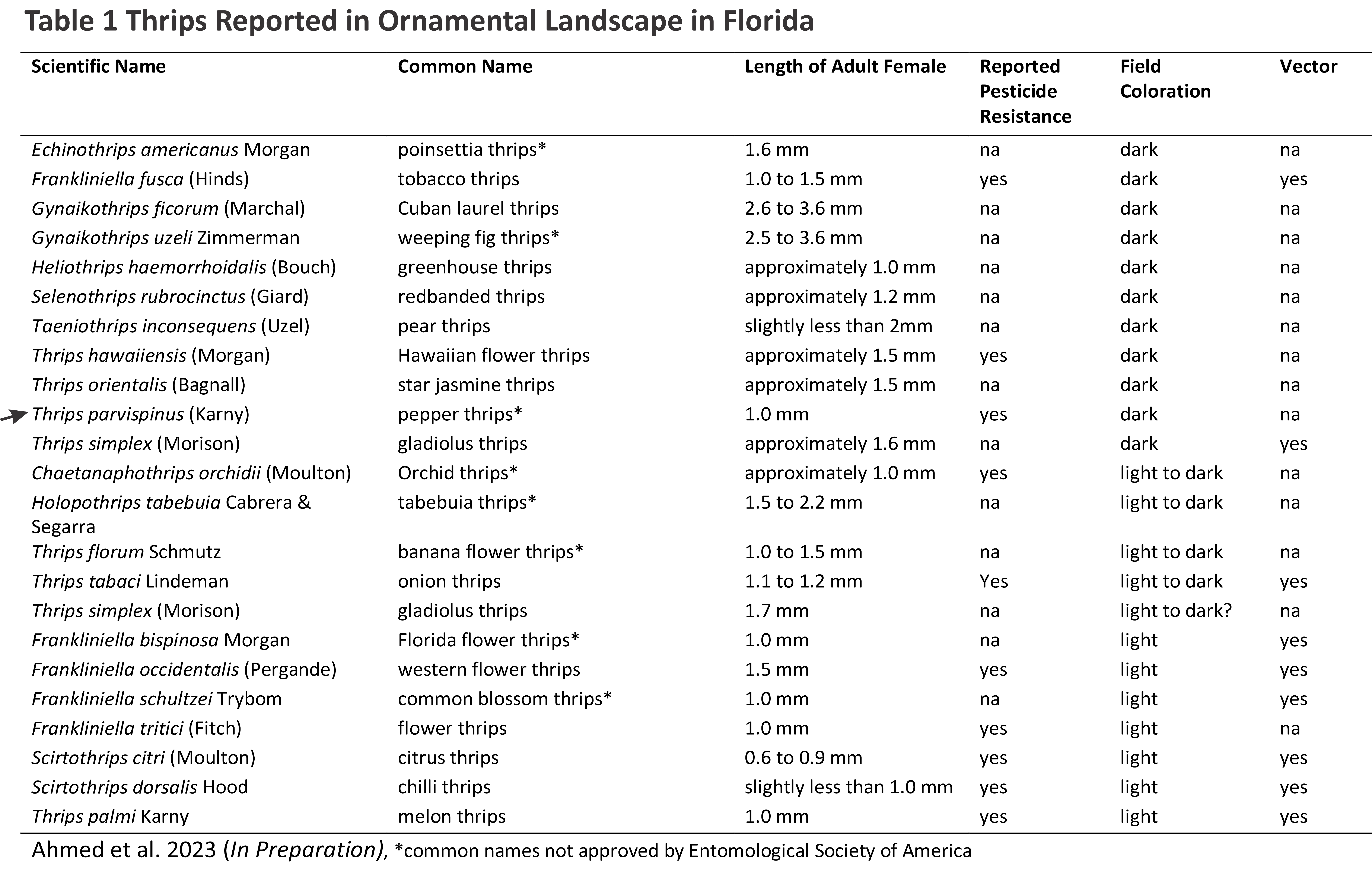
- Thrips parvispinus (Karny) is in dark-colored thrips with a brown head, yellow thorax, and black abdomen.
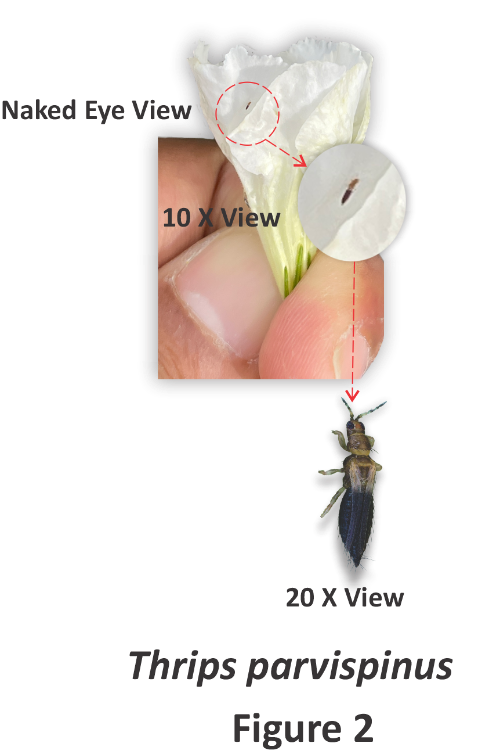
- In the following video, you can observe the females, with a dark mahogany-colored abdomen and light brown thorax (they are two-toned). There are also a few males, which are very much like chilli thrips (Scirtothrips dorsalis Hood) adults in appearance, being light tan to yellow. However, males of T. parvispinus are relatively small compared to chilli thrips.
- https://www.youtube.com/watch?v=lAfDJKmRbD4
Video: L.S. Osborne, UF/IFAS-MREC
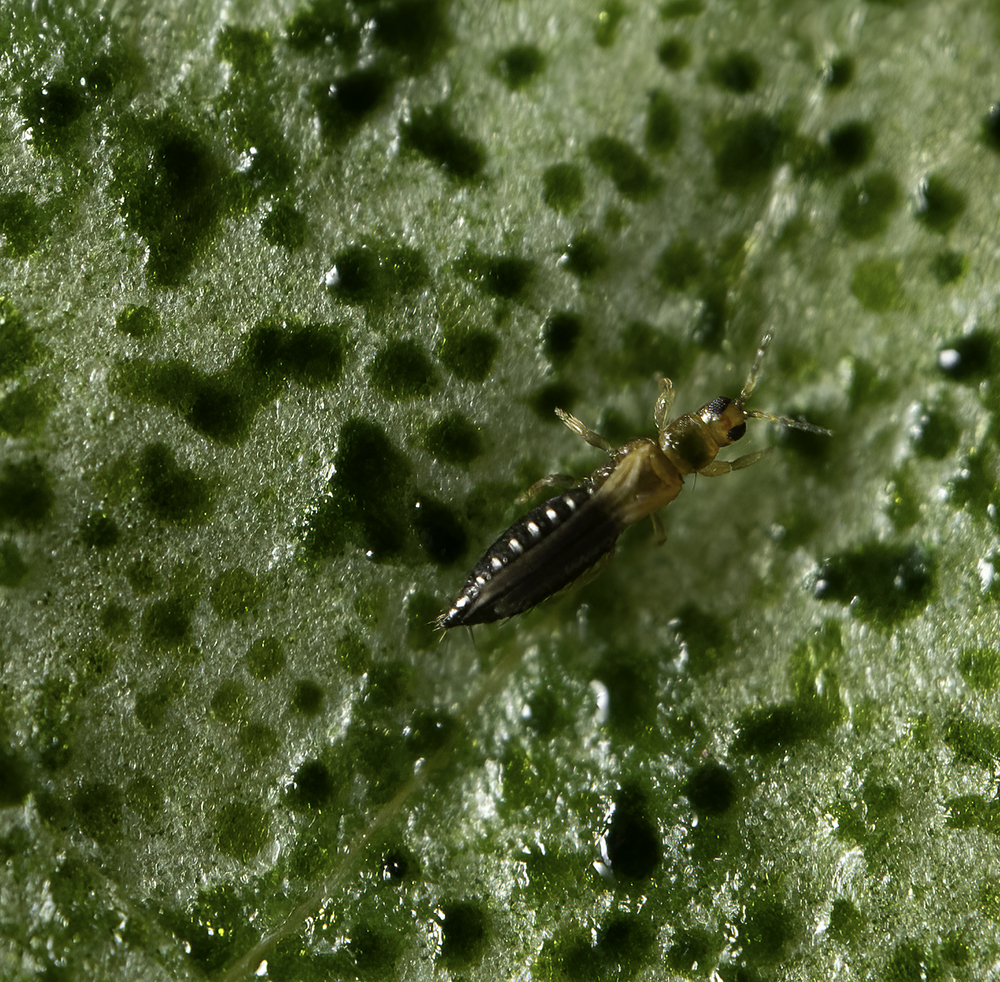
Adult female feeding on a bean leaf.
Photo: L.S. Osborne UF/IFAS-MREC
Thrips parvispinus female is nearly 1 mm long, making it one of the smallest thrips in Florida.
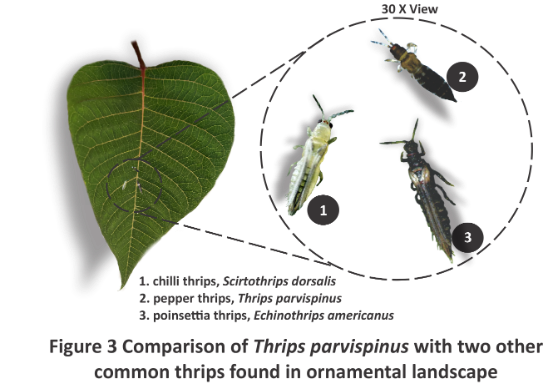
Thrips parvispinus is native to the Asian tropics and has been reported being present in at least 17 countries [Burundi, China, India, Indonesia, Japan, La Reunion, Malaysia, Mauritius, Myanmar, the Netherlands, Philippines, Singapore, Taiwan, Tanzania (Dar-el-Salam), Thailand, Uganda (Kampala), USA (Hawaii)] and intercepted in at least ten countries (Australia, France, Greece, New Guinea, New Zealand, Solomon Islands, Spain, Switzerland, the UK) from five continents (Africa, Asia, Australia/Oceania, Europe, and North America) in the last three decades (Ahmed et al. in preparation).
It is a polyphagous pest, reported feeding on at least 43 plant species from 19 families from different crop types, including fiber crops, fruits, legumes, ornamental plants, tobacco crops, and vegetables. This list is expected to grow (Ahmed et al. in preparation).
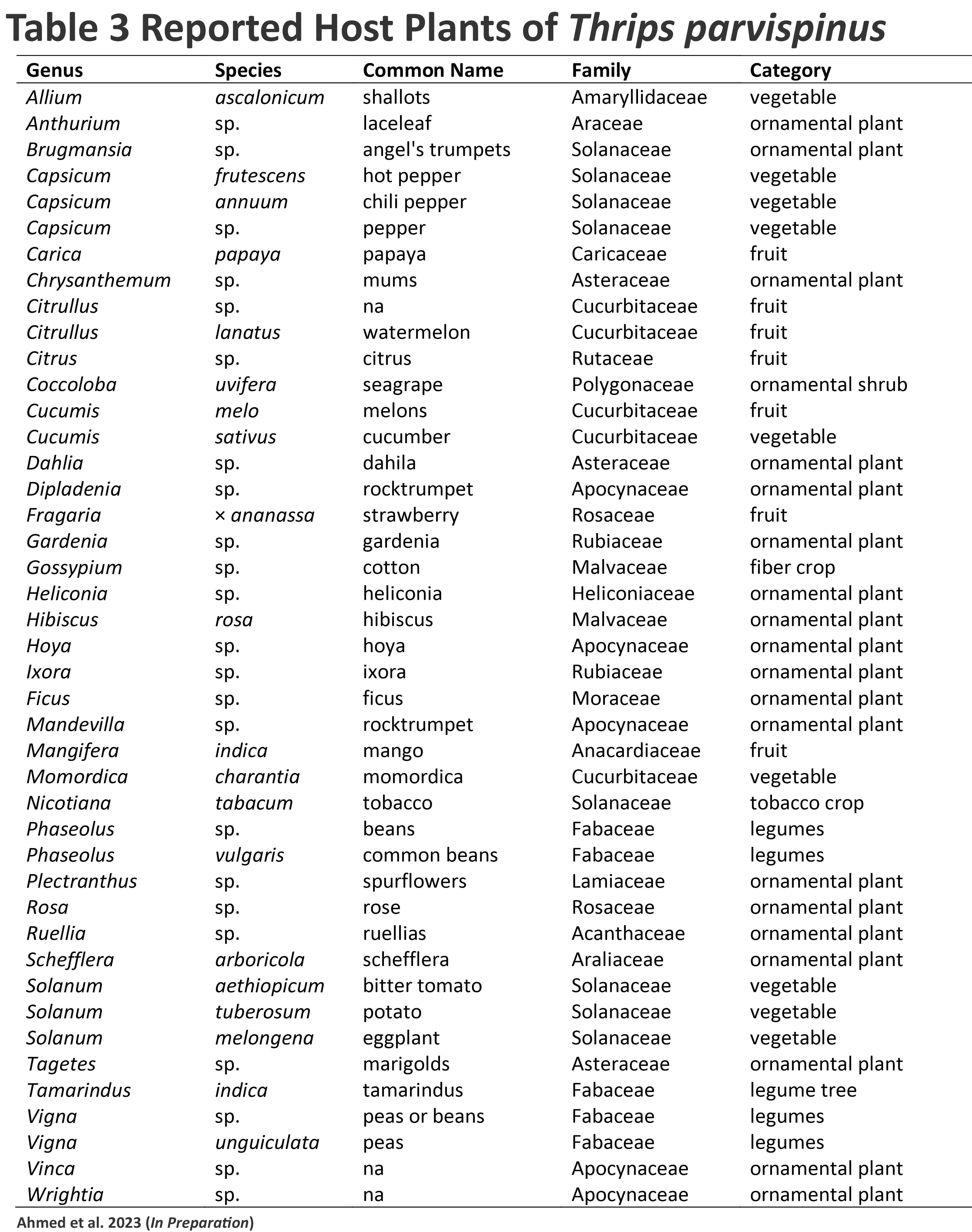
Thrips parvispinus completes a life cycle in 13–14 days on chili pepper under greenhouse conditions. Female thrips insert their eggs into the leaves, and larvae hatch after four to five days. The larvae feed on leaves and flowers while completing two molts in four to five days. Afterward, larvae become pupae and two to three days the adult emerges. Currently, we are uncertain what percentage of the population pupates in the soil but we feel some of the population does. According to Anthura, "These thrips are characterized by very entrenched behaviour. They prefer to hide in the young, rolled-up leaves, where they cause the most damage. Thrips’ pupation mainly takes place in the soil." Egg deposition takes place in the bract leaves, which can cause the characteristic small brown round spots on the flowers. These are especially visible on the light-colored varieties. Research is ongoing to clarify this aspect of their biology. The reproduction reported for this thrips is sexual. A female lays about 15 eggs and lives for nine days. Adult males live approximately six days.
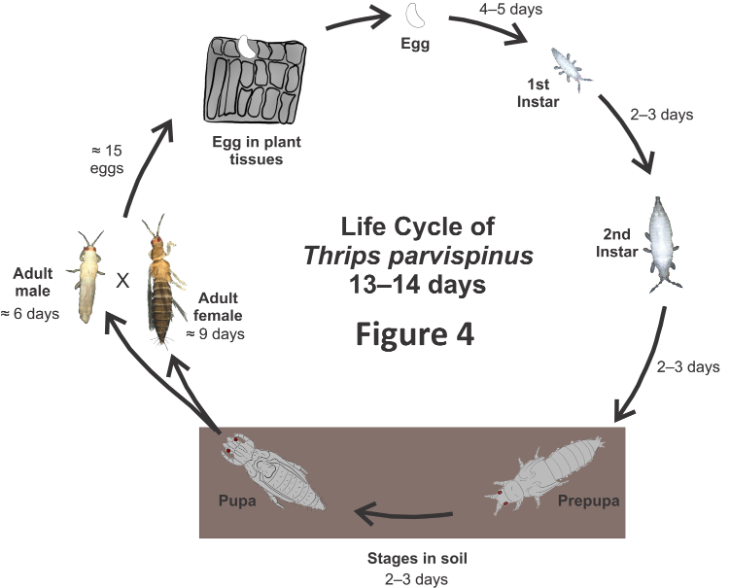
Thrips parvispinus prepupa in soil
.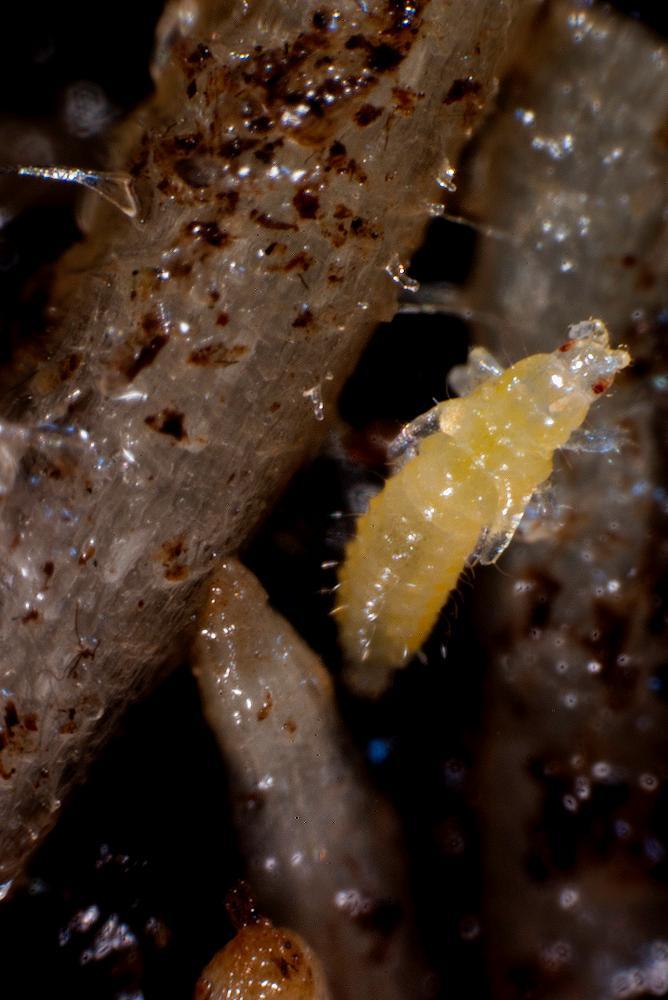
In the photo above, you can see the damage caused by a number of larvae.
Adult and immature of this species feed on leaves and flowers and damage may appear similar to broad mite damage and/or virus-infected plants. To be clear, Thrips parvispinus is not reported to transmit any viruses. To distinguish thrips damage from the broad mite damage, look for the presence of silver scars in all the foliage, specifically on the fully developed leaves. Broad mite damage is only concentrated on the new growth where the mites feed.
.
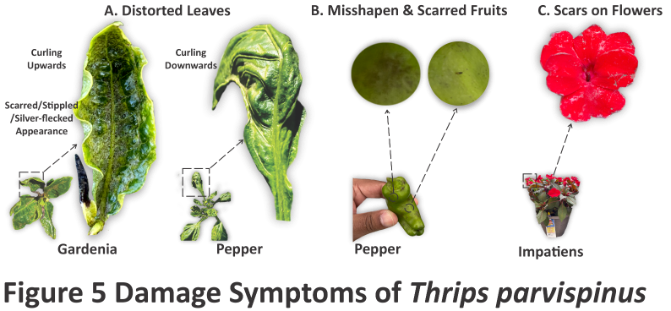
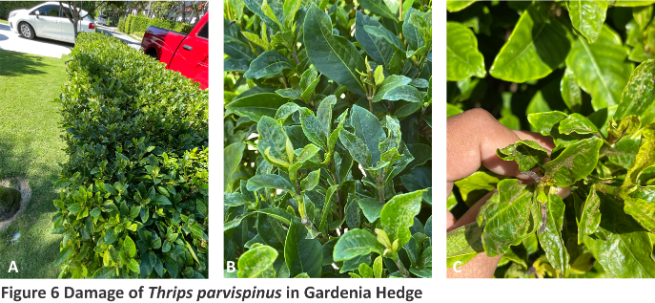
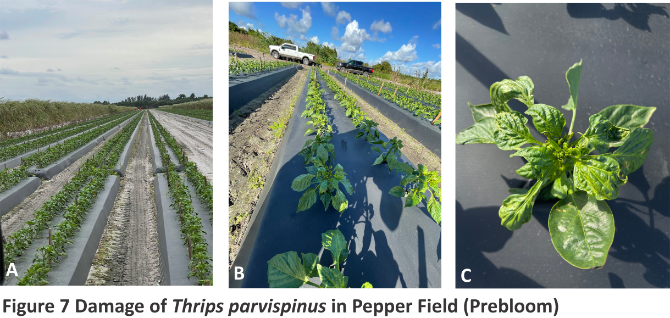
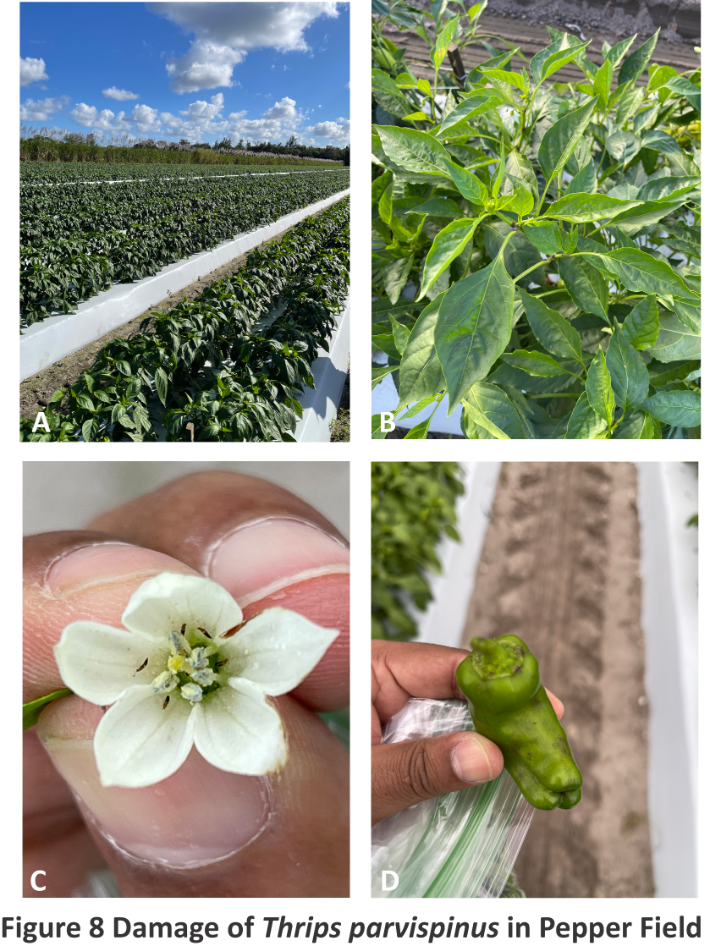
Scouting should be conducted by beating foliage over a white clipboard, and the number of adult and immature thrips should be counted immediately.
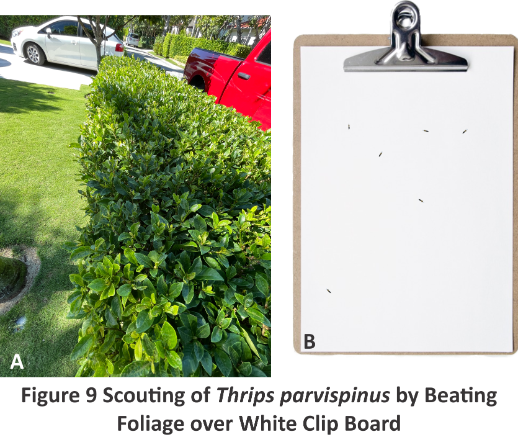
Here is the scouting sheet which could help see the size/appearance of T. parvispinus through naked eyes.
Scouting Sheet for Thrips parvispinus to Use on a White Clip Board
Early detection for ornamental plants should be conducted by searching and dissecting flowers for thrips.
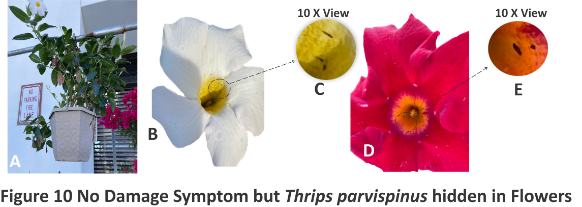
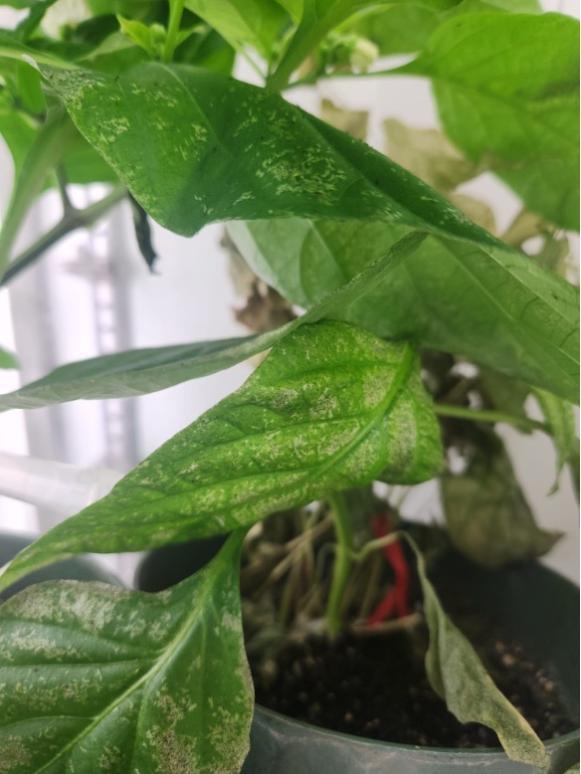
Photo: Alexandra M. Revynthi, UF/IFAS-TREC
Damage (silver scars) caused on bell pepper plants from feeding of Thrips parvispinus adults and larvae.
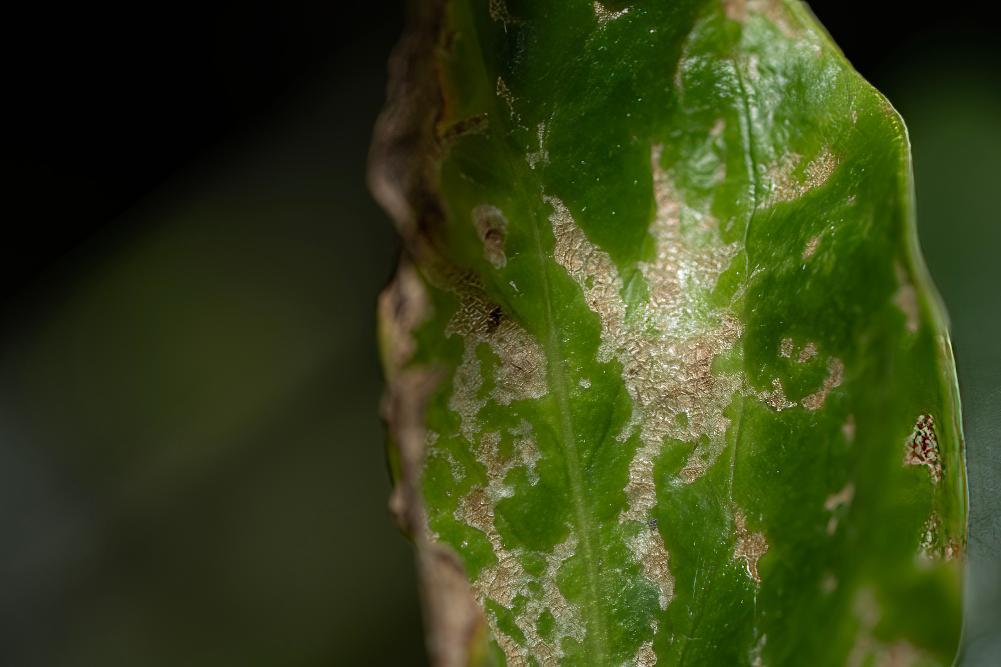
Photo: L.S. Osborne, UF/IFAS-MREC
Closeup view of a damaged pepper leaf.
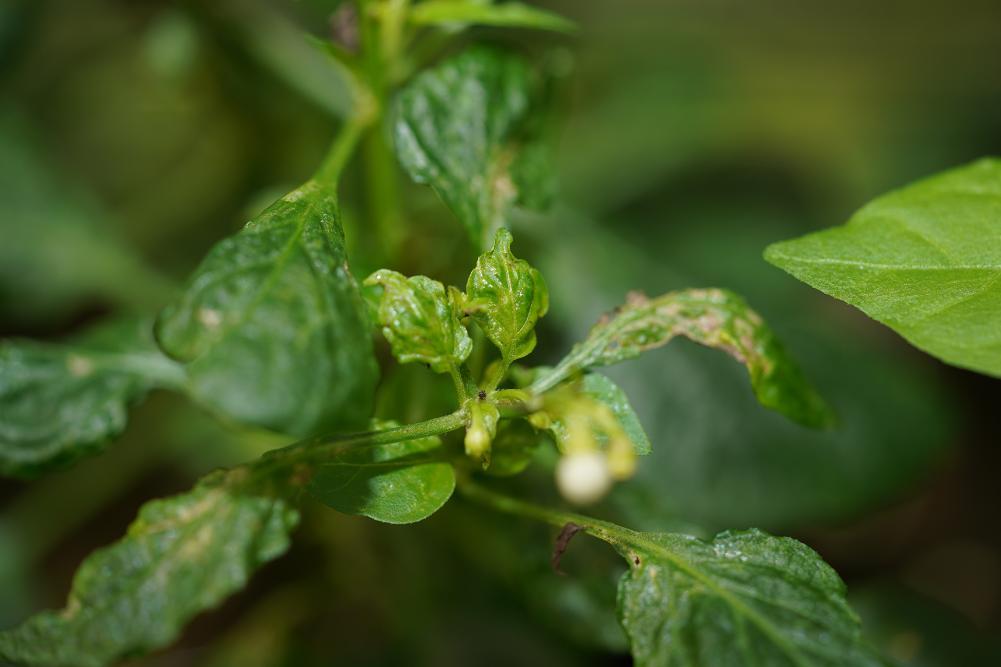
Photo: L.S. Osborne, UF/IFAS-MREC
New growth damage.
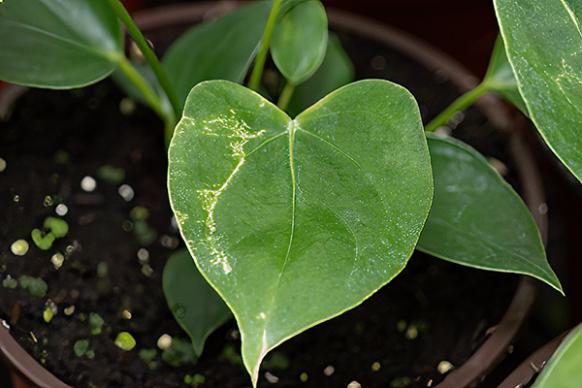
Photo: L.S. Osborne, UF/IFAS-MREC
Damage to an anthurium leaf.
Photo: Lyle Buss, University of Florida
Damaged gardenia terminal.
Photo: Lyle Buss, University of Florida
Damaged gardenia terminal.
-
Resources
Early detection for ornamental plants should be conducted by search and dissecting flowers for thrips.
Scouting Sheet for Thrips parvispinus to Use on a White Clip Board
Contact Detail for Sampling & Identification
- After using the field guide, if you believe you have Thrips parvispinus, please send us a sample for its positive identification and molecular analysis. We can send you sampling protocols and kits if needed. Please label each sample with its location (state and county), host plant and date of collection. As this invasive pest’s geographical distribution expands, we expect its host range to grow as well.
- For information about how to collect thrips samples and preserve them for evaluation and directions for scheduling shipments, you can contact: Dr. Cindy McKenzie, Research Entomologist, USDA, ARS, US Horticultural Research Laboratory 2001 South Rock Road Fort Pierce, FL 34945, Phone: 772-462-5917, Email: Cindy.Mckenzie@usda.gov
- For information regarding its field guide, scouting information, and tentative field diagnostics, you can contact Dr. Muhammad Ahmed, Research Entomologist, USDA, ARS, US Horticultural Research Laboratory 2001 South Rock Road Fort Pierce, FL 34945, Phone: 352-283-0173, Email: Muhammad.Ahmed@usda.gov
- PowerPoint and PDF files to supplement the information presented in this website.
- PowerPoint: https://mrec.ifas.ufl.edu/lso/PowerPoints/Parvispinus-powerpoint-3-16-2023.pptx
- PDF: https://mrec.ifas.ufl.edu/lso/PowerPoints/Parvispinus-powerpoint-3-16-2023.pdf
-
NEW Tri-Sate Greenhouse IPM Workshop LINK 1/25/2024
- Florida Commercial Vegetable Production Website which includes the Pest and Disease Hotline: https://commercialveg.ifas.ufl.edu/
- Tropical Research & Education Center Thrips parvispinus Resources by Alexandra Revynthi, UF/IFAS/TREC
- Tropical Thrips Species Intercepted on Plant Material in Ontario
- New thrips, new problems. Thrips parvispinus intercepted in Ontario
- The Importance of Inspecting Plants and Dipping Cuttings from Florida by Sarah Jandricic ONfloriculture
- Thrips parvispinus Webinar May 4, 2023. Here is the link to the recorded webinar.
- May 10, 2023. Thrips parvispinus: Identification, Scouting, and Potential Controls (tHRIve web series).
- May 30, 2023. Potential Solutions for Thrips parvispinus.
- https://firstdetector.org/sites/firstdetector.org/files/pdf/chili_thrips_deck.pdf
- Efficacy of Conventional and Biorational Insecticides against the Invasive Pest Thrips parvispinus (Thysanoptera: Thripidae) under Containment Conditions, January 2024
- https://onfloriculture.com/category/insect-pests/thrips-parvispinus/ Dr. Sarah Jandricic
- Chilli Thrips website
- EMAIL L.S. Osborne for access to PDF files and PowerPoint presentations (LSOSBORN@UFL.EDU)
-
Control Options
Some compounds have an impact on thrips but do not kill them immediately. Mainspring is one such compound. This compound results in susceptible insects not being able to feed and thus they die from dehydration or starvation, but this mortality can take days to be noticeable. Other materials may also take days to kill sensitive insects. Therefore, we recommend evaluating materials for efficacy in your crop at day 7 post-treatment.
Recent data by Dr. Alexandra Revynthi suggest that Mainspring and Acephate might not kill the thrips within the period of evaluation, i.e., 48h, but they did prevent significant feeding damage by the thrips after being exposed to either compound (Tropical Research & Education Center Thrips parvispinus Resources).
The list below was developed from efficacy trials for other thrips species, some trials conducted on papaya in the field and on beans targeting T. parvispinus in UF/IFAS lab trials by Dr. Revynthi.”
PESTICIDES KNOWN TO HAVE SOME EFFICACY ON THRIPS PARVISPINUS
Group Product Active Ingredient
1B Acephate 97 UP Acephate
1B DuraGuard ME Chlorpyrifos
5 Conserve SC Spinosad
5 + 4C Xxpire Sulfoxaflor + Spinetoram
6 Avid, Timectin Abamectin
13 Pylon Chlorfenapyr
21A Hachi-Hachi Tolfenpyrad
28 Mainspring GNL Cyantraniliprole
Each compound could have label requirements that might preclude their use on your crop or applying at your site (greenhouse vs. landscape) or even the frequency/number of applications per season. Please read the label or contract and Extension Professional in your state. Secondly, some growers are reporting increased efficacy when using certain adjuvants or tank mixing with other compounds. Research is currently being planned to sort these details out as well as increase the number of materials known to have activity on Thrips parvispinus.
As we get data to support the use of additional materials we will add them to this list.
Summary
- The sky is not falling - effective treatments are available.
- Vegetable growers have more chemical options than Nursery and GH growers, landscaper and PCOs will have the most difficult time due to the limited options available.
- Scouting is key because this pest is easy to miss at low levels and reproduces VERY rapidly. By the time the plant flowers and the thrips become obvious, it may be too late to easily manage the problem.
- Detections made from a potted plant (like Home Depot) are considered interceptions and not an established pest. So if you are a homeowner and feel you have this pest in your yard, please send us a sample to verify. It's very important to document established populations.
- Don't ever return plant material to your nursery that has been sitting in a retail nursery. You have no idea what could have gotten on your plants while they were in someone else's care.
Please visit the links below to get some information on managing this pest and potentially useful pesticides registered for managing thrips.
- The follow are links to a PowerPoint containing additional information about Thrips parvispinus and a PDF file made from the PowerPoint.
https://mrec.ifas.ufl.edu/lso/PowerPoints/Parvispinus-powerpoint-3-16-2023.pptx
https://mrec.ifas.ufl.edu/lso/PowerPoints/Parvispinus-powerpoint-3-16-2023.pdf
-
References
-
Ahmed, M.Z., A.M. Revynthi, C.L. McKenzie, and L.S. Osborne. (2023). Thrips parvispinus (Karny), an emerging invasive regulated pest in the United States.[https://mrec.ifas.ufl.edu/lsolab/thrips/thrips-parvispinus/][Date Accessed: March 11, 2023].
- Cristi Palmer and Ely Vea. 2022. IR-4 Environmental Horticulture Program. https://ir4.cals.ncsu.edu/ehc/RegSupport/ResearchSummary/ThripsEfficacy2022.pdf. [Date Accessed: March 11, 2023]
-
-
Acknowledgements and Contributors
Most of the images used in this webpage were taken and adapted by Muhammad Z. Ahmed. The permission was taken through emails by Muhammad Z. Ahmed for the images taken by other parties. Fig 1: Manfred Ulitzka (thrips-id) & Muhammad Z. Ahmed (USDA), Fig 2, 4–9, 11: Muhammad Z. Ahmed (USDA), Fig 3: Babu Panthi, (University of Florida), Felipe N. Soto-Adames (FDACS-DPI), Lance Osborne (University of Florida), Fig 10: Image credits were included in Ahmed et al. 2023 (In preparation).
RESEARCH SUPPORTED BY:
- USDA-ARS Floriculture and Nursery Research Initiative: “Evolving Integrated Management Plans for Major Arthropod Groups and New Invasive Pests of Ornamental and Floriculture Production”.
- FNGLA Endowed Research Fund: “Monitoring and Testing of Management Strategies for Thrips parvispinus (Karny) in Palm Beach County”
SITE DEVELOPED BY:
Caroline Warwick and we thank her for all she has done. The Banner photo of the healthy anthuriums was provided by Caroline as well.
If you have comments about content or issues with the site please contract Lance Osborne: lsosborn@ufl.edu


